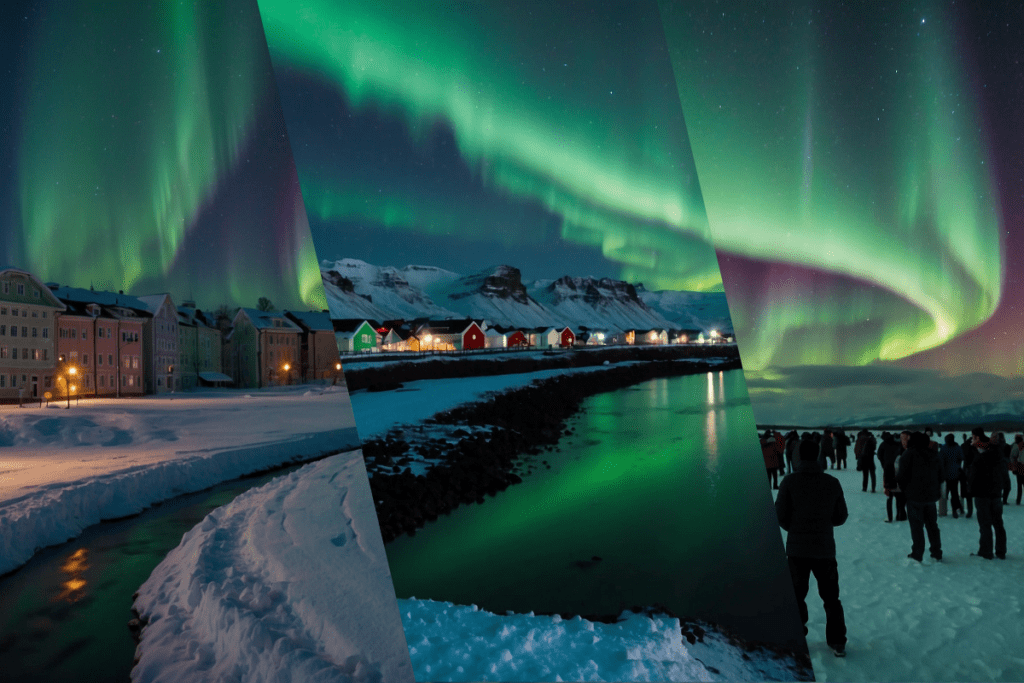AURORA BOREALIS , also known as the Northern Lights , is one of the most magical natural phenomena on Earth. These celestial displays of brilliant colors dancing across the night sky have captivated people for centuries, inspiring myths, legends and horror stories. In this blog, we delve into the magic of the Northern Lights, exploring their origins, the science behind them, and the best places to witness this breathtaking spectacle.
Origins and Mysteries – Auroras are created when charged particles from the sun collide with atoms and molecules in Earth’s atmosphere. These particles are attracted to the Earth’s magnetic poles, where they interact with gases such as oxygen and nitrogen. When these collisions occur, energy is released in the form of light, creating the dazzling displays we know as the Aurora Borealis.
While the science behind the northern lights is well understood, it still holds an air of mystery and wonder. For centuries, different cultures around the world have created myths and legends to explain these ethereal lights. In Norse mythology, the auroras were believed to be the armor of the Valkyries, female warriors who accompanied fallen warriors to Valhalla. In Inuit folklore, the lights were spirits of the deceased who played ball games with a walrus skull.
Science behind the show – Understanding the science behind the northern lights only adds to their beauty. The colors seen in auroras depend on the type of gas particles that collide with solar particles. Oxygen typically produces green and red hues, while nitrogen can produce blue, purple, and sometimes pink colors.
The intensity and frequency of the aurora also varies with solar activity. During periods of high solar activity, known as solar maxima, the northern lights can be seen more often and at lower latitudes. Conversely, during solar minima, the lights are less common and may only be visible in areas closer to the poles.
Best places to witness the Northern Lights – While the Northern Lights can theoretically be seen in areas near the Earth’s magnetic poles, certain locations offer the best chances to witness this celestial spectacle. The most popular destinations include:

IMAGE : NORTHERN LIGHTS IN DIFFERENT PLACE
1) Lapland, Finland – Located beyond the Arctic Circle, Lapland offers unspoiled wilderness and clear skies, making it an ideal location for aurora viewing. Visitors can enjoy activities such as dog sledding and snowmobiling while waiting for the Northern Lights.
2) TromsØ, Norway – Known as the “Gateway to the Arctic”, TromsØ is a vibrant city in northern Norway. Its coastal location and relatively mind climate make it a popular destination for Aurora chasers.
3) Abisko, Sweden – This small village in Swedish Lapland boasts some of the clearest skies in Europe, making it an excellent place to view the Northern Lights. Neraby Abisko National Park offers stunning views and opportunities for outdoor adventure.
4) Iceland – Iceland is a favorite destination for many travelers thank to its dramatic landscapes and geothermal wonders. Visitors can soak in the natural hot springs while keeping an eye out for the Northern Lights dancing overhead.
5) Alaska, USA – For those unable to travel to Europe, Alaska offers ample opportunity to experience the Northern Lights. Fairbanks in particular is known for its clear skies and aurora activity during the winter months.
Aurora viewing tips
Although witnessing the Northern Lights is an extraordinary experience, it is essential to be prepared for the conditions. Here are some tips to maximize your chances of seeing the Aurora Borealis :
Choose the correct time – The best time to see the Northern Lights is during the winter months when the nights are longest and the sky is darkest. Aim for clear nights with minimal light pollution for optimal viewing conditions.
Stay Patient – Mother Nature can be unpredictable, so be prepared to spend several hours outside waiting for the Northern Lights to appear. Pack warm clothes, snacks and hot drinks to keep you comfortable while you wait.
Forecast Check – Many websites and apps provide aurora forecasts that indicates the likelihood of aurora activity on a given night. Keep an eye on these predictions and plan your viewing accordingly.
Be Flexible – While specific destinations may offer better chances of seeing the Northern Lights, the weather can change quickly. Be prepared to adjust your schedules and travel to different locations as needed.
In conclusion, the Northern Lights are a testament to the beauty and wonder of our natural world. Whether you’re a seasoned aurora chaser or a first-time viewer, witnessing these celestial displays is an experience like no other. So buckle up, head north and prepare to be dazzled by nature’s spectacular light show.








0 Comments